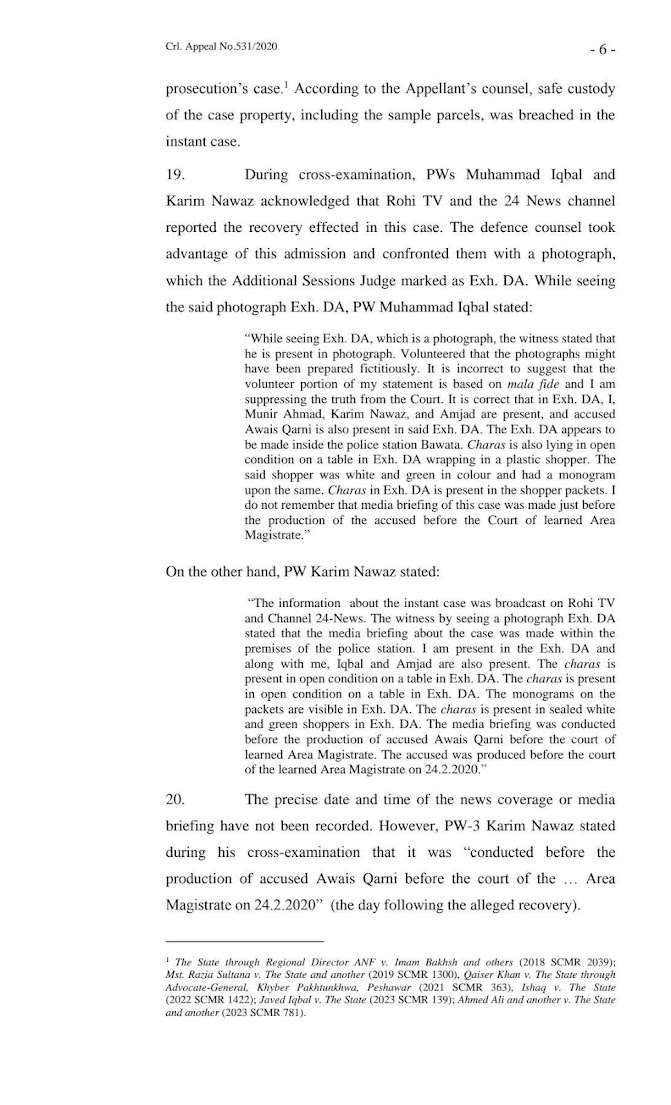ایک تصویر (یا کوئی بھی دستاویز) جو جرح کرنے والے کے پاس ہو سکتی ہے یا تو قابل قبول ہو یا ناقابل قبول۔ اگر یہ قابل قبول ہے، تو اسے اپنی حیثیت میں ثبوت کے طور پر پیش کیا جا سکتا ہے۔ اس کی ثبوتی قیمت اس بات کی تعمیل سے حاصل ہوتی ہے کہ یہ QSO کے تحت قابل قبولیت کے اصولوں کے مطابق ہے۔ آرٹیکلز 70، 71، 139، 140، اور 151(3) مل کر ایسے مواد کے ثبوتی سلوک کو منظم کرتے ہیں۔ آرٹیکلز 70 اور 71 ایک گواہ کو اس کے علم یا ادراک کے دائرے میں معاملات کے بارے میں گواہی دینے کی اجازت دیتے ہیں۔ اگر گواہ تصویر میں دکھائے گئے منظر کی شناخت کرتا ہے اور اس کی گواہی اس کی مشاہدات کے ساتھ ہم آہنگ ہے، تو اس کے بیانات کو براہ راست ثبوت کے طور پر قابل قبول سمجھا جاتا ہے۔ آرٹیکل 139 مزید یہ اجازت دیتا ہے کہ دفاعی وکیل تصویر کا استعمال گواہوں کی ساکھ کو چیلنج کرنے کے لیے کرے، ان کے بیانات کو جرح کے دوران تصویر میں دکھائے گئے منظر کے ساتھ موازنہ کر کے۔ اگر یہ قبول کر لی جائے تو تصویر ایک بنیادی ثبوت کے طور پر کام کرتی ہے، اور آرٹیکل 140 اس وقت متعلقہ ہو جاتا ہے جب اسے گواہوں کی یادداشت کو تازہ کرنے کے لیے استعمال کیا جائے۔ آرٹیکل 151(3) مزید یہ اجازت دیتا ہے کہ اگر تصویر کے حوالے سے تضادات یا اختلافات پیدا ہوں تو گواہوں کی ساکھ کا جائزہ لیا جائے۔ مختصراً، جب تصویر کی تصدیق ہو جائے اور یہ قابل قبولیت کی ضروریات کو پورا کرے، تو گواہوں کے بعد کے بیانات، جو ان کے ذاتی علم کی عکاسی کرتے ہیں، درست اور قابل قبول ہوتے ہیں۔
اس کے برعکس، اگر تصویر ناقابل قبول ہے کیونکہ یہ بنیادی (نئی) ثبوت کے طور پر اہل نہیں ہے یا ثانوی ثبوت کے طور پر مناسب تصدیق کی کمی ہے تو ایک مختلف تجزیہ لاگو ہوتا ہے۔ QSO کا آرٹیکل 70 یہ حکم دیتا ہے کہ تمام حقائق، دستاویزات کے مواد کے علاوہ، زبانی ثبوت کے ذریعے ثابت کیے جا سکتے ہیں، جبکہ آرٹیکل 71 کے مطابق زبانی ثبوت براہ راست ہونا ضروری ہے۔ یہ ایک گواہ کو صرف ان حقائق کے بارے میں گواہی دینے کی اجازت دیتا ہے جن کا انہوں نے براہ راست مشاہدہ کیا ہو۔ ناقابل قبول تصویر دکھائے جانے کے بعد کیے گئے مشاہدات اس معیار پر پورا نہیں اترتے۔ ایسے منظرنامے میں، آرٹیکل 139 کا اطلاق محدود ہے، کیونکہ کوئی فریق ناقابل قبول مواد کا استعمال کرتے ہوئے گواہ کی بات کی تردید نہیں کر سکتا۔ اسی طرح، آرٹیکل 140 غیر متعلق ہو جاتا ہے کیونکہ ناقابل قبول تصویر یادداشت کو تازہ کرنے کے لیے استعمال نہیں کی جا سکتی۔ جبکہ آرٹیکل 151(3) گواہ کی ساکھ کو متاثر کرنے کی اجازت دیتا ہے، دفاع اس مقصد کے لیے ناقابل قبول ثبوت پر انحصار نہیں کر سکتا۔ اس کے مطابق، عدالت کو تصویر اور اس پر مبنی کسی بھی مشتق گواہی کو نظرانداز کرنا چاہیے کیونکہ ایسی بیانات کو قبول کرنا ثبوت کی سالمیت کے اصولوں کی خلاف ورزی کرے گا۔
A photograph (or any document) in possession of the crossexaminer may be either admissible or inadmissible. If admissible, it can be introduced into evidence in its own right. Its evidentiary value stems from compliance with the principles of admissibility under the QSO. Articles 70, 71, 139, 140, and 151(3) collectively govern the evidentiary treatment of such material. Articles 70 and 71 permit a witness to testify about matters within their knowledge or perception. If the witness identifies (naeem)the scene depicted in the photograph and their testimony aligns with their observations, their statements are admissible as direct evidence. Article 139 further allows the defence counsel to use the photograph to challenge the credibility of witnesses by comparing their statements during cross-examination with the scene shown in the photograph. If admitted, the photograph serves as substantive evidence, and Article 140 becomes relevant if it is used to refresh the witnesses’ memory. Article 151(3) further allows scrutiny of the witnesses’ credibility if inconsistencies or contradictions arise concerning the photograph. In short, when the photograph is authenticated and meets the admissibility requirements, subsequent statements of the witnesses, reflecting their personal knowledge, are valid and admissible.




















0 Comments